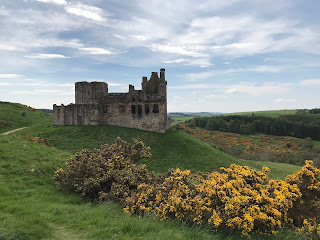Today I
went for a walk to Leith Walk Railway Bridge, a place that is no more and was
taken down years ago. However, the viaduct
buildings and the abutments that the bridge sat on are still there.
The
bridge was built as part of Caledonian Railways, New Leith Line, that ran from
Newhaven to the east of Leith Docks. It
crossed over Leith Walk from the viaduct at Jane Street over to the viaduct at Manderston
Street and on to the docks. An elevated
two platform passenger station was also built at Manderston Street but was
never used. The railway never carried
passengers and was instead used as a goods line. The line was closed in 1968. The bridge was dismantled and taken down in
1980.
The Leith
born poet, Jock Scot, recalled that he used to live near to the bridge, and it
was something he saw as being part of the fabric of Leith Walk. One day he and his family went off on holiday
and when he came back the bridge was gone.
Being upset about the disappearance of the bridge he wrote a poem for it
called ‘Farewell to Ferodo.’
Today, on a hot summer’s day I took a stroll down Leith Walk accompanied by the noise of heavy machinery from the ongoing tram works, that take up much of the road and pavement at the moment. I then cut round the back of the buildings that ran along the Walk to the bridge. Most of these are now empty and will form part of a development project that is rumbling its way through the council Planning Department. There is then a dirt path that leads up to where the railway ran. It is fenced off, but part of the fence has been removed, so it is easy to gain access to…for just now anyway.
The walls
that run along the viaduct buildings on the Jane Street side of Leith Walk are
colourful with graffiti, while the track bed for the railway is now very
overgrown. Looking out over the walls
there were some great views over Leith and up Leith Walk into Edinburgh.
I left
the Skulferatu that accompanied me on today’s walk in a gap in the wall near to
some metal girders that would have once been part of the bridge over Leith
Walk.
The
coordinates for the location of the Skulferatu are –
Latitude 55.968975
Longitude
-3.173440
























































